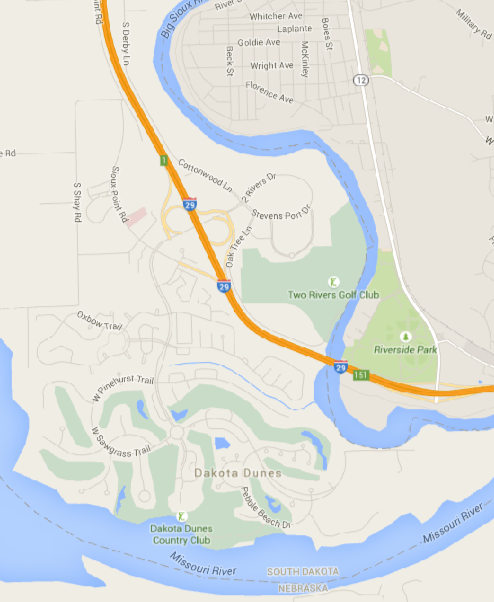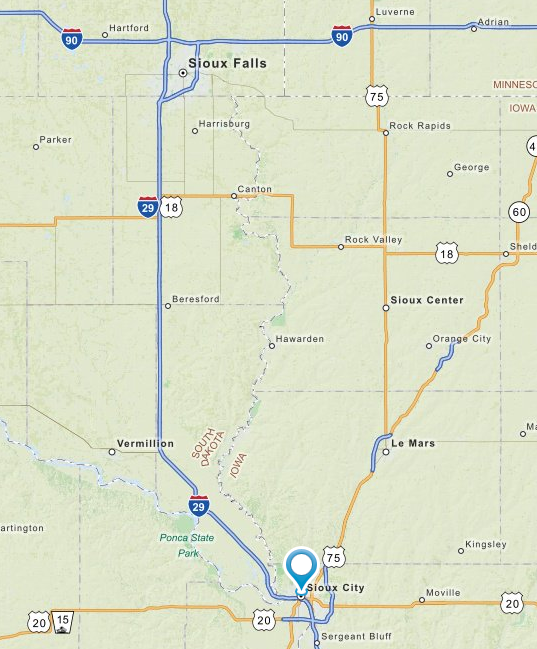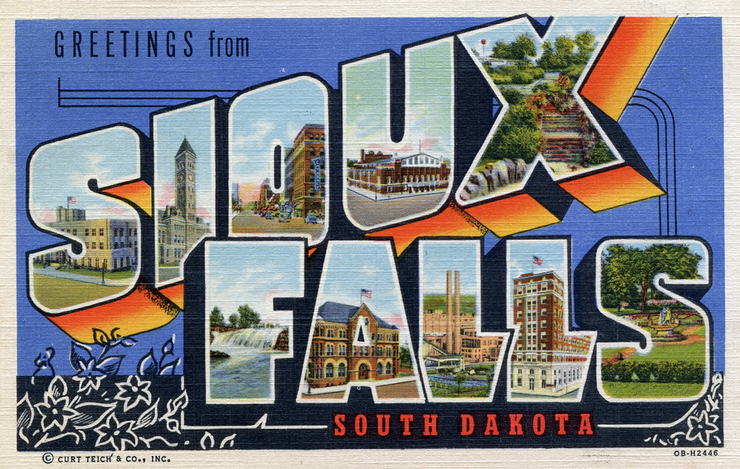Sioux Falls rises, as Sioux City falls
This follow-up post is only for tax nerds; it gets pretty deep in the weeds, or wheat fields. I was interested in this comment in a WSJ piece on Governor Brownback, who’s struggled to enact supply-side reforms in Kansas:
During a brief presidential run in 2007, Mr. Brownback said he saw economic growth in parts of South Dakota””where there is no income tax””outpacing activity just across the border in Iowa, which has such a tax.
Iowa doesn’t just have a state income tax; they have a relatively high one, topping out at 8.98%. Sioux City, Iowa and Sioux Falls, South Dakota are both quite close to the border, and so I decided to investigate these two “urban” areas. Both towns are mostly in one county, with some suburbs that spill into another county. Sioux City, Iowa also has some suburbs that cross state lines into both South Dakota and Nebraska. I’ll consider the cross-state suburbs later. Here’s the general area:
From Sioux City, Interstate 29 extends northwest into a wedge of South Dakota, and highway 20 goes west into Nebraska.
Now let’s compare the population of the two South Dakota counties containing the Sioux Falls area with the two Iowa counties containing the Sioux City area:
Year Sioux City Sioux Falls
1990 121,664 139,236
2000 128,726 187,093
2010 127,158 228,261
2014 127,145 240,204
1990-2014: +4.5% +72.5%
That’s quite a difference. The spillover counties don’t have enough people to change the overall picture, but S. Sioux City, Nebraska is growing faster than Sioux City, perhaps due to the lower tax rates in Nebraska, and N. Sioux City, South Dakota is growing even faster (despite being less conveniently located):
Year S. Sioux City N. Sioux City
1990 16,742 10,189
2000 20,253 12,584
2010 21,006 14,399
2013/14 20,947 15,029
Growth +25.1% +47.5%
There’s good and bad news here for supply-siders. The good news is that substantially lower tax rates may lead to faster growth in border areas. The bad news is that this growth may involve merely a beggar-thy-neighbor effect, not true supply-side inducements to work, save and invest more. Indeed it’s exactly this concern that has progressives in Europe worried about a corporate tax race to the bottom, and has them calling for minimum tax rates. Is Brownback merely trying to steal jobs from Kansas City, Missouri, which is right on the state line?
In a recent interview, the governor pointed to a record number of Kansans employed in the private sector and a jump in new business starts, all while one of the state’s largest industries, aviation manufacturing, struggles. The governor added that employment is particularly strong along the Kansas-Missouri border, where it is easiest for businesses and people to cross state lines to respond to the tax cuts.
“It’s like going through surgery. It takes a while to heal and get growing afterwards,” Mr. Brownback said in his office, a painting of Ronald Reagan hanging behind him. “The left in the country desperately wants this to fail. They want to say, ‘You can’t cut taxes and grow your way out of things.’ “
Surgery, or stealing kidneys from one person and implanting them in another?
Here’s Brownback’s problem; Iowa’s top rate is 8.98% higher than South Dakota’s, whereas even after the tax cut Missouri’s top rate is just 1.4% above Kansas. And Kansas is still 4.6% above Texas and South Dakota. I believe Kansas will gradually steal some jobs from Kansas City, especially due to the elimination of taxes on small businesses. But there won’t be any supply-side miracles.
If you look at cities using google maps, the old neighborhoods often follow a grid, and the newer suburbs have curvy streets. If they are particularly affluent, the development will line a golf course. That’s what happened across the river from Sioux City, in the only part of the metro area having any growth since 2000:
 And here’s what Wikipedia has to say about the upscale community:
And here’s what Wikipedia has to say about the upscale community:
Dakota Dunes has five main neighborhoods including the Country Club Estates, the Meadows, the Prairie, the Willows, and Upscale Apartment Living.
Dakota Dunes is owned and developed by Berkshire Hathaway Energy of Des Moines, Iowa, which unveiled plans for the community in 1988.[4] The development is home to Dakota Dunes Country Club, a golf course designed by Arnold Palmer‘s design company.
I might have known the Sage of Omaha would be involved in this somehow.
And Wikipedia has this to say about Union county:
Union County is part of the Sioux City, IA–NE-SD Metropolitan Statistical Area. Progressive Farmer rated Union County second in the 2006 “Best Place to Live” in the U.S., because “its schools are good, its towns neat and its people friendly.”
I’m packing my bags right now. (No one ever described Boston people as “friendly.”) I can’t end this post without saying at least something good about Iowa. The Wikipedia page for Sioux City has this picture of the courthouse:
Tyler gives you pictures of ugly buildings that are actually sort of beautiful. I make things easier for you; I give you pictures of attractive buildings that are actually kinda beautiful.
And since we are out in that area, I’ll bet not one American in ten could name America’s longest river (it’s not the Mississippi):
Tags:






14. June 2015 at 17:59
Everyone in both Sioux City and Sioux Falls know that if you want a hot time you have to go to Fort Dodge.
14. June 2015 at 18:20
Living in Sioux City right now. Would be happy to answer any questions. Although the tax rates play a part in the growth, there is a lot more to the equation. Sioux City used to have the stockyards and was “little chicago”. Since the stock yards left, Sioux City has never really gained its mojo. Average age is about 10 years higher than Sioux Falls if I remember correctly. Some of Sioux City’s major businesses have their corporate office on the other side of the boarder, but I haven’t really noticed any major shift to move to Dakota Dunes / North Sioux City. Dakota Dunes are where the rich families flock to for obvious reasons. I believe the country club in Dakota Dunes is the second best country club in the state of SD.
14. June 2015 at 18:25
It’s pretty difficult for a state to have taxes that are very progressive, so total levels rather than the form (top tax rate on income or consumption) is probably what is important And there locales have to match taxes to the degree of services provided. High tax-good service and low tax-poor service can both be equilibria that different voting demographics can choose.
15. June 2015 at 05:57
Was this post motivated by an upcoming trip to this area of the country?
15. June 2015 at 06:44
Noontime, I’ll need to check that place out sometime.
Stephen, Thanks for the info. I seem to recall that Sioux Falls attracted companies like credit cards, is that right?
Thomas, I disagree, I think the form is really important. Although I do plan to move the California, their highly progressive tax system would be a big negative if I was looking at financial self-interest. Quality of services is also a factor, as you say.
Niklas, No, but I’ve always wanted to canoe down the Missouri.
15. June 2015 at 07:16
Hey Scott, I’m a legal resident of South Dakota. Visited the state a grand total of three days, enough to establish my legal domicile. I got a one-way ticket to Sioux Falls if you want it.
15. June 2015 at 08:56
You should do some field research on the NH/MA state line.
https://goo.gl/maps/LMnn8
15. June 2015 at 09:10
If you look closely, you will notice 7 restaurants in MA. (9% meals tax in NH)
But all the malls, furniture and big boxes are in NH. Plus a dozen or so “Tax View” cul-de-sacs.
15. June 2015 at 09:25
Aren’t we trying to draw too many conculsions for individual state economies which can vary greatly. Especially looking at states that have had only moderate increases in population since 1930. (Can you believe North Dakota highest Census was 1930? Although they are higher now)
I assuming most ‘non-energy’ states are not growing very fast is companies are slow to move with a tight skilled labor market, the tax savings are not a large piece, and most red states are more socially dysfunctional than blue states as measured by percent of children with married parents. (Still true if you fix for minority populations.)
15. June 2015 at 09:57
Ray Lopez, that’s a tricky game you’re playing.
http://money.cnn.com/2013/06/18/pf/taxes/state-tax/
15. June 2015 at 11:17
Simply bc there’s nowhere recent to put it:
http://www.washingtonpost.com/blogs/wonkblog/wp/2015/06/15/the-big-problem-with-one-of-the-most-commonly-cited-numbers-about-the-economy/
And again Scott, the digital deflation brigade isn’t going anywhere.
Eventually we win, you just need to get right with us before it happens.
15. June 2015 at 12:00
Yes, lowering taxes on your own citizens is indistinguishable from stealing kidneys. I see that now.
Thanks for the insight Scott!
15. June 2015 at 12:18
People moving from one state to another for tax reasons is not supply side magic but it is a good thing. Taxes are the price we pay for government, if South Dakota can provide government an acceptable for 2% less per year then that is a great efficiency.
15. June 2015 at 12:25
Steve, Actually I don’t see much evidence of a state line effect. Both sides of the border are about equally populated. But for retailers and restaurants you are probably right.
Collin, I don’t think any sensible person would draw sweeping conclusions based on one example.
Morgan, There’s is nothing to win because it doesn’t matter what the numbers are; these are just statistics pulled out of thin air. Only NGDP is real. And NGDP growth is slowing.
bmcburney, If you ever start blogging you will quickly discover that the world is full of people with no sense of humor.
15. June 2015 at 14:38
Bob Murphy: very uncharitable to Yglesias:
https://mises.ca/posts/blog/krugman-and-yglesias-get-tough-with-the-bankers-after-it-doesnt-matter
15. June 2015 at 14:54
“Morgan, There’s is nothing to win because it doesn’t matter what the numbers are; these are just statistics pulled out of thin air. Only NGDP is real. And NGDP growth is slowing.”
SORRY SCOTT
Your precious is a little b*tch compared to mine.
REAL CONSUMPTION measures in Digital > Atomic is the highest moral metric.
YOUR JOB is to argue that your precious at X% best services my precious.
What we’re not sure of is X – they are not all the same…
bc you haven’t proven:
1. If any given NGDPLT can service my precious equally, WHO CARES what it it is?
2. IF some NGDPLT is better than another FOR MY PRECIOUS – which is and why?
All we require is subservience to our precious Scott!
We are easy to satisfy!
15. June 2015 at 18:23
Thanks Travis.
Morgan, OK, tell me how fast real consumption is rising, to within 3 decimal points. Show your work.
I keep telling you there is nothing to measure, you are in angels on a pin territory.
15. June 2015 at 18:48
“Morgan, OK, tell me how fast real consumption is rising, to within 3 decimal points. Show your work.”
Sure!
The invisible real consumption measure is this:
How much less money will you live with today to not have to live yesterday without access to today’s things?
Whatever you attribute to “money illusion” there is a greater gravity pulling the another way.
I don’t deny Money Illusion has a short term weighted value. But I don’t need 10 years to show digital deflation.
Since 2008, measuring real consumption, the quality of American (not easy to benefit 3rd worlders) life has increased at a pace faster than ANY 7 years period pre-Internet in American history.
So here’s my work:
1. Scott Sumner finds the best 7 years in real consumption in American history pre-1994.
2. 2008-today is rising faster than that.
And here’s your three decimal points…
——–
Scott, we don’t have to argue. You’re wrong about measuring consumption.
But that doesn’t make NGDPLT incorrect, it just means that you need to argue within the framework of “this is the best time ever”
Which means show us how we WOULD have EVEN MORE destruction of atomic businesses 2008-today, even FEWER retail stores, even FEWER commercial office buildings, even FEWER kids on college campuses, etc had NGDP been 5%.
We need to set NGDP according to what makes 1994+ happen FASTER.
You can do it Scott. I’m counting on you!
16. June 2015 at 03:21
“Technology matters in this context for two reasons,” Moe explained to me. “First off, technology literally won me a life. All Syrians I know as émigrés or refugees have struggled to accept/integrate/adjust/adapt with the new life. It’s a life without history, a life where you have to prove yourself all over again. Because of technology, I – anyone – can speak the modern language. I’m an international resident, I’m already part of the new world. Second, because of technology I was able to start my company after a couple of months. Technology is cheap and you can reach millions easily. I can start a company, try and fail quickly without costing a fortune. If it works I build jobs for many. If not, when I’m looking for a job then that’s what everyone is looking for – a workforce with tech skills.”
http://www.syriadeeply.org/articles/2015/06/7424/making-impossible-syrians-refugee-teens-building-futures/